
* In the 1990s, the US combat services and Britain collaborated to develop a "Joint Strike Fighter (JSF)", which would emerge as the Lockheed Martin "F-35 Lighting II", and is now becoming a mainstay of Western air forces. This document provides a history and description of the F-35. A list of illustration credits is included at the end.
* After the Clinton Administration took office in 1992, a number of reviews of defense acquisition programs were performed. At the time, several government organizations were working on next-generation strike aircraft. The US Navy had been working in secret on an advanced stealthy strike aircraft named the "A-12 Avenger II" -- but the program ran into financial trouble, and was canceled shortly after going public in 1991. The Navy requirement remained open and evolved into a new effort designated "Attack / Fighter Experimental (A/F-X)". The USAF was also considering a next-generation strike aircraft and a replacement for the F-16, with the designation of "Multi-Role Fighter (MRF)".
On another track, the US Marine Corps had been interested in a follow-on for their AV-8B Harrier II "short take-off / vertical landing (STOVL)" attack aircraft; while the British Royal Navy wanted a next-generation STOVL fighter to replace their Sea Harrier naval STOVL fighters. The two services collaborated on STOVL research in the late 1980s, with control of this effort finally picked up in 1989 by the US Defense Advanced Research Projects Agency (DARPA), the Pentagon's "blue sky" investigations office.
DARPA conducted studies on new STOVL concepts over the next few years. During this time, the USMC had expanded their vision from a STOVL aircraft to replace the Harrier to one that would also replace their F/A-18 Hornet fighters. DARPA began to see the advanced STOVL fighter as a basis for a "conventional take-off & landing (CTOL)" aircraft as well, and the concept became known as the "Common Affordable Lightweight Fighter (CALF)".
In September 1993, the Clinton Administration killed the Navy A/F-X and Air Force MRF projects. The Pentagon was allowed to set up a research office to investigate "Joint Advanced Strike Technologies (JAST)" applicable to fulfilling these requirements at some unspecified time in the future. A few months later, the US Congress mandated that the DARPA-led CALF research effort be merged into the JAST office.
At first, the JAST office was generally regarded as just another inept defense boondoggle -- but under the direction of Air Force Major General George Muellner, it quickly attained a critical mass for actually building a next-generation strike fighter. Muellner wanted to build a "universal fighter" that would fulfill the needs of all the participants, and was able to get everyone pulling in more or less the same direction.
One of the primary goals of the JAST effort was "affordability". In the wake of the end of the Cold War, procurement funds for new combat aircraft were hard to come by, particularly because the Clinton Administration was determined to balance the budget while simultaneously conducting expensive military interventions all over the world. Although the US economy was booming at the time, that ironically led to further constraints on the military budget, since the services had to increase pay to keep their people.
* The JAST concept that emerged did not define a single aircraft, but three different aircraft based on common technology:
The JAST also had to perform a secondary air-defense mission, using air-to-air missiles (AAMs) to defend itself, or to protect fleet assets from airborne intruders. High performance was not a requirement, though of course it was desireable. Performance was specified to be comparable to existing F-16s and F/A-18s operating in the strike role, though any incidental improvements in performance were welcome. Nominal top speed was specified as Mach 1.5, or about 1,600 KPH (1,000 MPH).
The answer to all these requirements was to develop a CTOL aircraft at a base price for the USAF requirement, and variants at incrementally higher prices with features added for CV or STOVL operations. The STOVL variant was to have essentially the same performance as the other two variants. That was an ambitious requirement, but the DARPA STOVL studies had indicated that STOVL technology had finally matured to the point where such a thing was possible.
The JAST concept that emerged envisioned a stealthy, single-seat aircraft, with a high degree of cockpit automation to make life easier for the pilot. It would be fitted with an advanced radar system, working in conjunction with other electronic and infrared systems for defense and all-weather attack, but would not feature a highly optimized integration of systems in order to lower costs and preserve flexibility.
The stealth requirement meant that JAST would be able to accommodate a small warload internally, consisting of two guided munitions and a pair of AAMs; and when required, a much larger warload on underwing stores pylons. The JAST would operate strictly with internal weapons during initial phases of an air campaign, allowing it to perform stealthy strikes to suppress air defenses or hit heavily defended targets, and then carry heavier external loads in later phases of a conflict. The JAST office referred to this operational concept as "first-day stealth".
BACK_TO_TOP* Major aircraft manufacturers began to investigate JAST designs in 1994. The JAST program office issued a request for proposals in March 1996. A short time later, the project name was changed to "Joint Strike Fighter (JSF)" to indicate that they were working on real flying hardware, not blue-sky design concepts. Given that the program envisioned production runs of thousands of aircraft, there was intense interest from the US aerospace community. Three companies offered proposals to meet the JSF request:
The STOVL designs from all the manufacturers had the same infrared signatures in normal flight as the CTOL and CV variants. That was an improvement from the Harrier, whose four rotating exhaust nozzles arranged around the aircraft's center of gravity were regarded by critics as providing a perfect "bulls-eye" for heat-seeking missiles.
* In 1996, the Boeing and Lockheed Martin concepts were selected as finalists, and both companies then began formal development of demonstrator aircraft. The elimination of McDonnell Douglas from the competition was a major blow to that company, and one of the contributing factors to the firm's subsequent buyout by Boeing. Boeing planned two "X-32" demonstrators, while Lockheed Martin planned one "X-35" demonstrator.
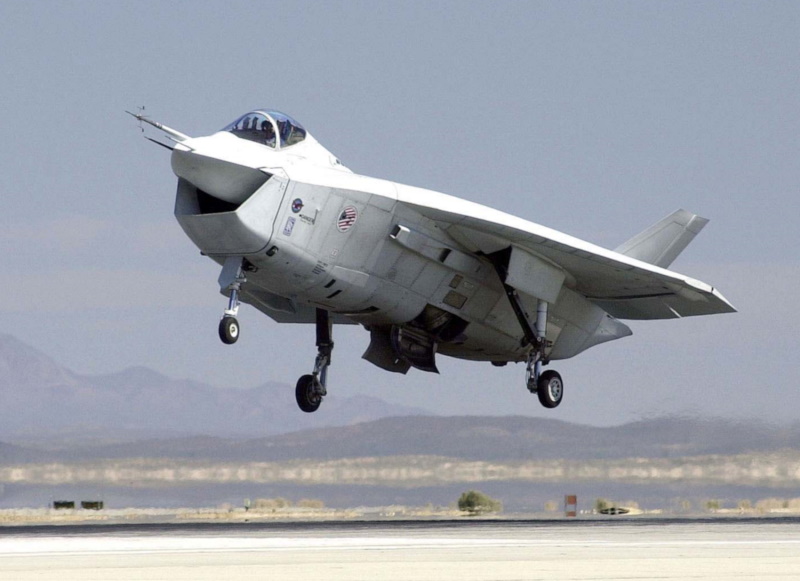
In 1998, Boeing performed a major redesign of its JSF concept to reduce cost and weight, changing its pure delta-wing configuration by adding a conventional tailplane. The Boeing demonstrator were not changed to the new configuration. First flight of the Boeing "X-32A" CTOL demonstrator was on 18 September 2000. First flight of the "X-32B" STOVL demonstrator was in March 2001, with vertical flight testing beginning in June 2001.
First flight of the Lockheed Martin "X-35A" CTOL demonstrator was on 24 October 2000, with first flight of the "X-35C" CV variant on 16 December 2000. The X-35A was then updated into the "X-35B" STOVL demonstrator by addition of the lift fan system and other hardware, with initial vertical flight testing in June 2001.
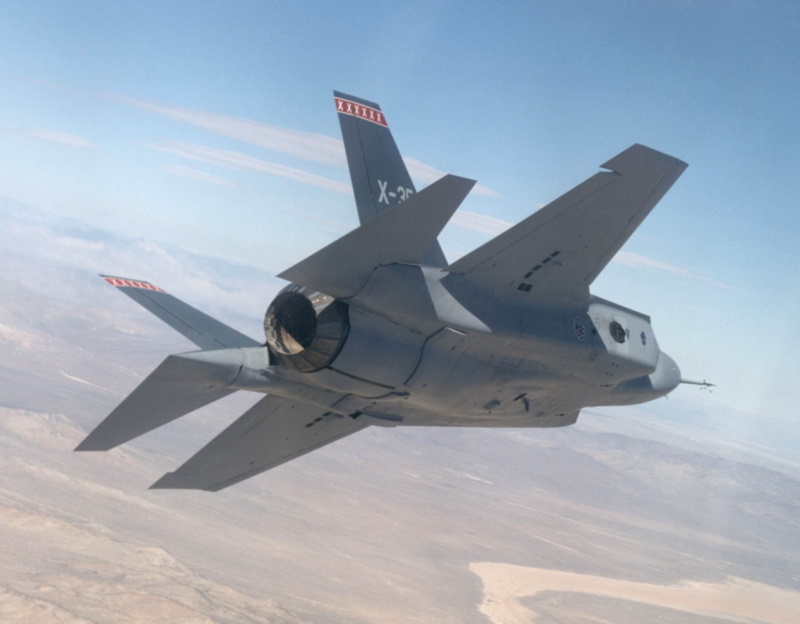
In October 2001, the Lockheed Martin X-35 was selected as the winner of the competition. Boeing was perceived as having the edge in management, while both companies were rated equally on cost and support. However, the Lockheed Martin design was seen as involving lower risk, with the lift-fan concept for the STOVL variant scoring particular points for the win. Lockheed Martin released a "finalized" design for the production F-35 in the summer of 2002.
The British ended up at odds with the Americans over the program for a time. The British wanted to have "operational sovereignty" over their F-35s, allowing them to modify and upgrade their machines as they wished. The sticking point was that this meant the Britain would be supplied with the source code for the F-35's elaborate computer software, and the Americans were reluctant to give it up, fearing that security would be compromised. In late 2006, an agreement was hammered out; the details were secret, but it was clear that the UK was not going to pull out of the program.
The British had a long discussion over the quantities of VTOL versus CV machines, but finally settled on an F-35B VTOL fleet, with two new carriers to support the force. The F-35 was given the official name of "Lightning II" in the summer of 2006, as a tribute to both the US Lockheed P-38 Lightning and the British English Electric Lightning. As for the two Boeing X-32 demonstrators, they are both now museum pieces.
* The initial "system design & development (SDD)" phase of the F-35 program involved the construction of 15 flight-test aircraft and seven static-test airframes. The F-35B ran into problems with "weight creep", with Lockheed Martin performing substantial redesign of structural elements and other features to trim well more than a tonne off the fighter's weight, allowing it to return to a carrier without having to dump heavy munitions.
First flight of an SDD aircraft, an F-35A CTOL variant, was on 15 December 2006, with company test pilot Jon Beesley at the controls. An F-35B performed its first (conventional) take-off on 11 June 2008, with CTOL flights from early 2009. The first F-35C was rolled out on 29 July 2009, with first flight in November 2011. By early 2014, over 100 F-35s had been built. The US Marines were the first to announce operational capability, with the F-35B going into formal service with the Marines in the summer of 2015. The Air Force followed in the summer of 2016. By the summer of 2018, over 300 F-35s had been produced.
The F-35 program has had plenty of real difficulties, enough to lead to a change in management, and there have been cutbacks in the number of projected aircraft to be built as unit price increased. The big problems have now been sorted out; yes, despite the hopes for affordability early on in the program, it's ended up an expensive aircraft, but it will also serve for decades, amortizing the purchase cost.
BACK_TO_TOP* As it emerged, the F-35A was a modern jet fighter of broadly conventional configuration, with mid-mounted wedge-shaped wings, twin outward-canted tailfins, and stealthy lines, the airframe featuring over a third composites by weight. Much work was conducted on reducing the cost of composite assemblies, which were traditionally extremely expensive. In fact, the F-35 was designed to be as cheap to manufacture as possible, using the latest computer-aided design and manufacturing tools.
The airframe used "radar absorbent materials (RAM) to make it stealthier, though it is unclear how much of the RAM was coating or was part of the composite sections. Incidentally, F-35s have been observed flying with skins with a mosaic of highly-reflective material, possibly in trials for advanced RAM technology, but nobody is talking about it.
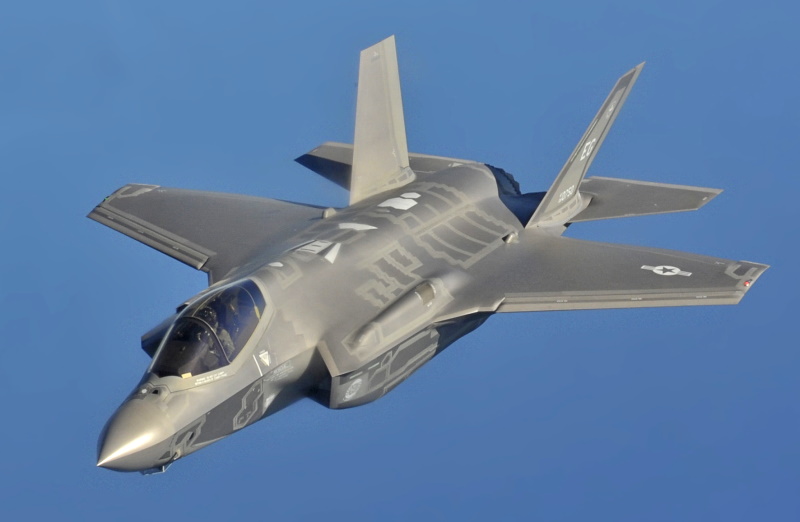
The pilot sat under a front-hinged canopy. The F-35A had tricycle landing gear, all gear with single wheels and hydraulically actuated, with the steerable nose gear retracting forward, the main gear pivoting forward into the wing roots. The production F-35 had a nose 12 centimeters (5 inches) longer than the X-35 demonstrator, while the tailplane was moved back 5 centimeters (2 inches), and the tailfins were rearranged a bit.
___________________________________________________________________
LOCKHEED MARTIN F-35A LIGHTNING II:
___________________________________________________________________
wingspan:
10.67 meters (35 feet)
wing area:
42.74 sq_meters (460 sq_feet)
length:
15.67 meters (51 feet 5 inches)
height:
4.57 meters (15 feet)
empty weight:
13,170 kilograms (29,035 pounds)
normal take-off weight:
24,350 kilograms (53,680 pounds)
MTO weight:
27,215 kilograms (60,000 pounds)
max speed at altitude:
1,930 KPH (1,200 MPH / 1,040 KT)
service ceiling:
15,000 meters (50,000 feet)
range:
2,800 kilometers (1,700 MI / 1,500 NMI)
combat radius:
1,240 kilometers (770 MI / 670 NMI)
___________________________________________________________________
The wings and tailplanes had a leading-edge sweep of 33 degrees, and trailing-edge sweep of 14 degrees. The tailfins had a sweep of 42 degrees, and a cant of 19 degrees from the vertical; the X-35 had a cant of 25 degrees. Each wing had a full-span leading-edge flap, and a single large "flaperon" -- flap-aileron -- at the rear. The tailfins had one-piece rudders, and the tailplanes were all-moving. There was no air brake, the flight control system instead manipulating the flight control surfaces in a collaborative fashion for braking.
All the flight controls, except for the electromechanically-driven leading-edge flaps, were driven by an interesting "electro-hydrostatic actuation system (EHAS)", in which the actuators were all hydraulic -- but were self-contained and driven by electrical signals, not operating off a central hydraulic system. That combined the power of hydraulic systems with the greater reliability of electrical systems. While the individual weight of each of the EHAS actuators was more than that of a traditional actuator, the overall system weight was less.
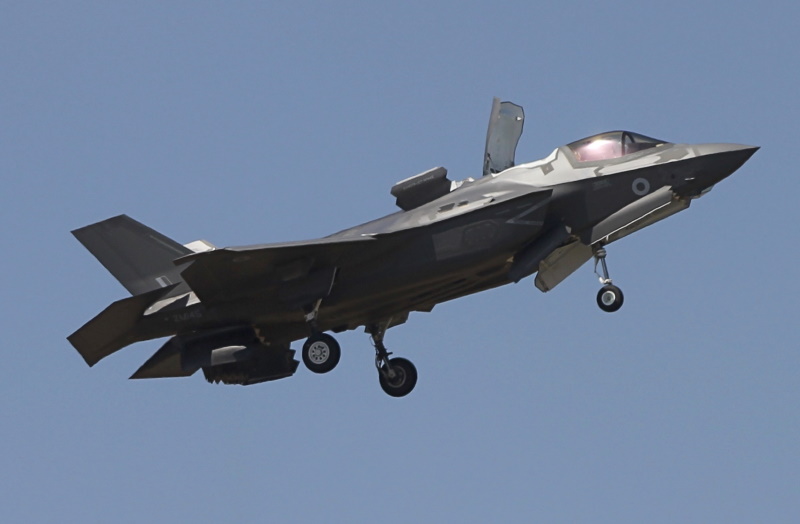
The F-35B STOVL version had shorter tailfins, implemented as part of the weight-reduction redesign. The Air Force F-35A had a refueling-boom socket behind the cockpit, while the F-35B and F-35C had a retractable refueling probe on the right side of the nose. Both these variants had an empty weight about 1,400 kilograms greater than that of the F-35A.
Compared to the USAF F-35A CTOL variant, the USN F-35C CV variant had a larger wing, span being 13.11 meters (45 feet), with 45% more area than that of the F-35A; the tail surfaces were also longer. The larger flight surfaces gave it better range and good low-speed carrier landing characteristics. The wing featured folding wingtips, with span reduced to 9.47 meters (31 feet 1 inch) when folded; it also added an aileron beyond the fold. Of course, the F-35C had stronger landing gear and an arrestor hook.
The F-35 was powered by a modified version of the P&W F119 engine, designated the "F135". While it was as powerful as the original F119, it was much cheaper, since it used lower-cost components at the expense of greater weight. It had the same thrust levels as the F119, with 151 kN (15,420 kgp / 34,000 lbf) dry thrust and up to 222 kN (22,675 kgp / 50,000 lbf) afterburning thrust. The engine intake ducting was arranged in a "serpentine" fashion, to eliminate radar reflections from the compressor blades.
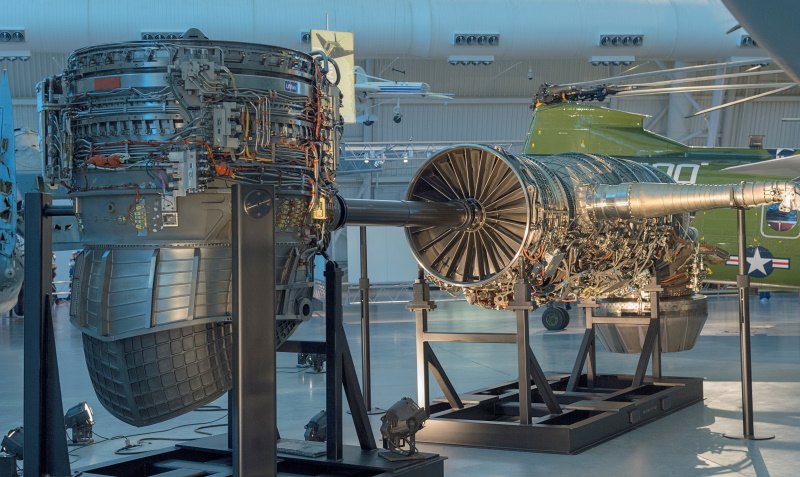
The shaft-driven lift fan for the STOVL F-35B was built by Rolls-Royce / Allison, and provided up to 80 kN (8,150 kgp / 18,000 lbf) of lift thrust. The lift fan was covered by a hydraulically-actuated door when not in use; there was also an auxiliary air inlet on the aircraft's spine behind the door to provide more airflow to the engine when the fan was in operation. Total internal fuel capacity of the F-35A was 10,500 liters (2,775 US gallons); the F-35B's fuel capacity was about 25% less, while the F-35C's were about 10% more. There were fuel tanks in the wings, fuselage, and even the tailfins.
Even before the flight of the X-35 demonstrators, the US Congress had been pushing for an "Alternate Engine" as a backup plan. The GE F120, originally designed for the F-22 program in competition with the P&W F119, was selected as the Alternate Engine, and modifications to the F120 as the "F136" for the F-35 were pursued by a collaboration of GE, Allison, and Rolls-Royce. The program proved controversial, critics arguing that there was no need for the F136 proportional to its cost; given funding constraints, the effort was finally killed off in late 2011.
P&W designed a "Block 1" variant for the F135 engine, to provide at least 5% better fuel efficiency and 10% more thrust, with the Block 1 being fitted in later production, and earlier engines being upgraded as F-35s are run through scheduled overhauls. P&W is developing an "Enhanced Engine Package (EEP)" of updates of the engine, for introduction in the 2030s, that will improve thrust by at least 10%, reduce fuel consumption by at least 5%, and increase vertical lift thrust by about 2%.
The Pentagon is now working on an "Adaptive Engine Transition Program (AETP)" to develop a next-generation fighter powerplant. An "adaptive cycle engine" is a type of jet turbine engine that can use three different air streams, depending on whether an aircraft needs more efficiency or power, with maximum airflow for cruising mode, airflow being cut back for combat power. General Electric is working on the "XA100" while P&W is developing the "XA101" for AETP. While current thinking is that the F-35 will get the AETP engine, P&W believes that EEP will be a more cost-effective option, so the issue remains open.
* The F-35 had two weapons bays, each of which could accommodate a single Joint Direct Attack Munition (JDAM) GPS-guided bomb and an AIM-120 Advanced Medium-Range Air-to-Air Missile (AMRAAM) -- or two AMRAAMs. The F-35A and F-35C could carry two 900-kilogram (2,000-pound) JDAMS internally, while the STOVL F-35B was limited to internal carriage of two 450-kilogram (1,000-pound) JDAMs. The F-35A and F-35C variants had bulged weapons bays to accommodate the larger munitions; the F-35B's weapons bays had less internal volume. Lockheed Martin eventually designed a stores rack that allowed an F-35A/C to carry three AMRAAMs in a weapons bay, for a total of six. The rack didn't fit on the F-35B.
All variants of the F-35 could carry up to eight 112-kilogram (250-pound) Small Diameter Bombs (SDBs) internally. The two bays had two doors each, with the AMRAAM fitted on a launch rail on the inner door. The Air Force is planning to enhance the F-35A to carry two B61 Mod 12 GPS-guided / variable-yield nuclear weapons internally, and is working on a variant of the US Navy's "AGM-88G Anti-Radiation Guided Missile / Extended Range (AARGM-ER)" -- an improved AGM-88 "High-Speed Anti-Radiation Missile (HARM)" in a wingless configuration for internal carriage.
Four stores pylons could be attached to all variants to provide a much heavier warload, at the expense of stealth. The inner pylon on each wing was rated for up to 2,270 kilograms (5,000 pounds), while the outer pylon was rated for up to 1,135 kilograms (2,500 pounds). Maximum stores load was 9,070 kilograms (20,000 pounds).
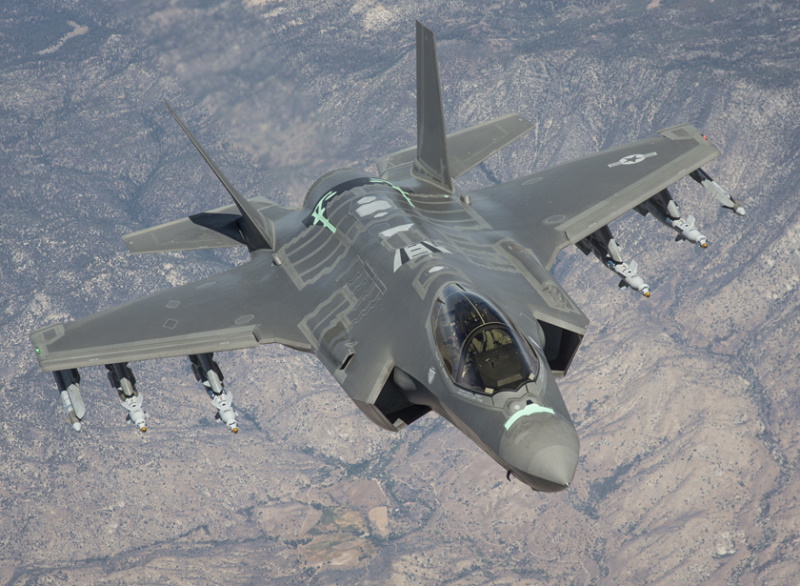
Only the USAF F-35A had a built-in gun. Early plans were for carriage of a variant of the Mauser BK-27 27-millimeter revolver-type cannon, but the final decision was to go with the GE GAU-12/U 25-millimeter five-barrel Gatling-type cannon, like that used on the US Marine AV-8B Harrier. It fired out the top of the left wingroot and had a store of 182 rounds. Maximum rate of fire was 3,300 rounds per minute. The other variants did not have a built-in gun, but could carry a "stealthy" cannon pod for the GAU-12/U between the weapons bays, with the pod accommodating 220 rounds of ammunition. Early F-35 software blocks did not support the cannon.
As for the future, Lockheed Martin has discussed the possibility of the F-35 carrying laser weapons, with P&W considering enhancements to the F135 engine to provide the power to drive them. There's been a great deal of progress in combat laser systems in this century, but when they actually become fully operational on the battlefield remains to be seen. Lockheed Martin also proposed a drone version of the F-35, but there were no takers.
BACK_TO_TOP* The sensor suite for the F-35 was developed by Northrop Grumman. The initial design assumption was that the JSF would be a consumer of sensor data, obtaining information from specialized intelligence-gathering aircraft, satellites, and other sources. This approach promised to keep costs down. However, as the pieces began to fit together, something different emerged. That was partly due to the "bottom-up" realization that the new technologies being developed for the JSF were far more powerful than had been considered; and to the "top-down" realization that the numbers of expensive specialized intelligence-gathering aircraft would be small, while there could be thousands of JSFs.
The F-35 came to be seen more as a producer of sensor data, with each aircraft interacting through high-speed datalinks with other platforms to provide greater "electronic domination of the battlespace". If the other platforms were F-35s, they would be able to cooperate to provide a capability greater than the mere sum of the parts.
The heart of the F-35's sensors was the Northrop Grumman AN/APG-81 radar, based on the AN/APG-77 AESA developed for the F-22. As with the AN/APG-77, the F-35's AN/APG-81 provided a range of functions, acting as a multimode radar; active jamming system; passive electronic defense system; and communications system. The AN/APG-81 used improved technology compared to the F-22's AN/APG-77, but airframe constraints mean that it had fewer T/R modules, limiting it to about two-thirds the range (165 kilometers / 90 nautical miles) of the AN/APG-77. Work is currently underway on the "AN/APG-85", an advanced replacement for the AN/APG-81, as part of a comprehensive "Block 4" F-35 update. Details have not been released.
The US Marines considered a specialized two-seat electronic warfare (EW) derivative of the F-35, the "EF-35", but decided that the F-35B and the AN/APG-81 would provide a useful EW system -- with software to allow a single-seat aircraft to do the job, and possibly help from external conformal EW modules when required by the mission. That would permit a larger and, on a unit price base, cheaper buy of F-35Bs, and more flexible operational use of the aircraft.
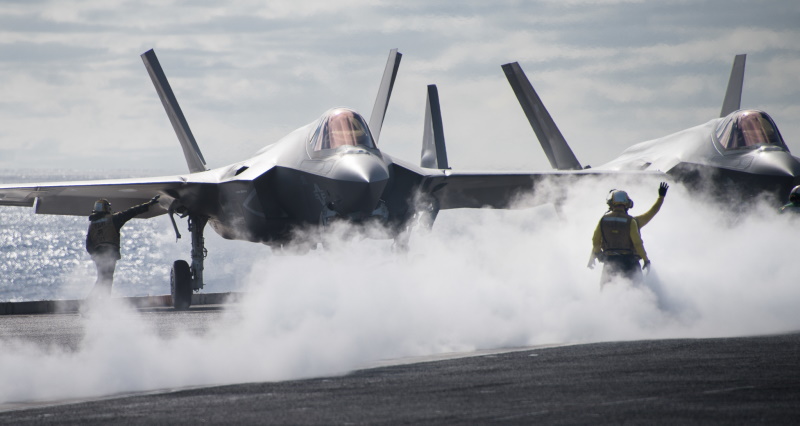
* The F-35 was fitted with other sensor systems, including an "infrared search and track (IRST)" system for defense and air-to-air combat, and a targeting system for precision attack on ground targets. The IRST system was known as the "distributed aperture infrared system (DAIRS or DAS)". DAS included six IR sensors mounted on different points of the fuselage to provide full-sphere IR detection and tracking. DAS could identify and pinpoint both incoming missiles and airborne targets.
Targeting was performed by the "electro-optical targeting system (EOTS)", featuring a forward-looking infrared (FLIR) imager; a CCD TV camera; a targeting laser; and a laser spot tracker. Unlike typical contemporary targeting systems, EOTS was not turret-mounted. It had a wide aperture that was blended into the aircraft's nose contours, covered by a window opaque to radar. EOTS was derived from technology developed for the Lockheed Martin "Sniper" targeting pod; it has been refined, particularly to provide better imaging resolution, after entering service. Other avionics included:
BAE Systems is now working on a new EW suite for the Block 4 update. Details are not yet available.
* The F-35's software collected the inputs from all the sensors, as well as inputs relayed over high-rate datalinks, to provide sensor fusion and seamless data display -- pilots describing the capability of the sensor system as "mind-blowing". There were two datalink systems -- the "Link16", which is a standardized high-bandwidth datalink, and the "Multifunction Advanced Data Link (MADL)", which was a "stealthy" datalink intended to hook up cooperating teams of F-35s.
MADL could also link into wider tactical networks, the Marines having performed experiments in hooking up F-35s into the "Naval Integrated Fire Control / Counter Air (NIFC-CA)" system. In these experiments, the F-35s acted as surrogates for the Northrop Grumman E-2C Hawkeye airborne early warning platform, with the F-35s penetrating protected airspace, targeting missile launches from warships to engage air and ground targets. F-35 operators have considered the utility of the type as an "intelligence, surveillance, & reconnaissance (ISR)" asset, using its advanced sensors and datalink capabilities to coordinate battlefield operations. The ISR role might involve software updates to optimize the F-35 for the mission.
The F-35's software was executed on an "integrated core processor (ICP)". The ICP served as a central "brain" for the aircraft, integrating all the other electronics systems and coordinating them for display to the pilot, and also executing the pilot's commands. This system was vitally important, there being only one seat in the aircraft, with the pilot needing help to carry out the mission. The processor system was linked to the aircraft subsystems over a triple-redundant MILSTD 1394B high-speed serial bus network.
Northrop Grumman selected a "commercial off-the-shelf (COTS)" processor system for the ICP. The F-35 ICP was cheaper than the F-22's "Integrated Core Processor", which was designed a decade ago, but was an order of magnitude more powerful. One of the functions of the central processing system was to provide "automatic target recognition & classification (ATRC)". It could often identify specific targets, and if it couldn't say exactly what a target was, it could at least categorize the unknown targets into distinct sets.
The processing power of the F-35 presented the electronics system developers with a formidable software challenge, with the F-35 using millions of lines of code, over twice as much as the F-22. The F-35 not only had a more advanced electronics system, but it operated in both air-to-air and air-to-ground modes, and had three different versions. The software design strategy focused on modularizing the code so that the portions that were unique to each F-35 variant could be isolated, and the remaining code used as-is on all three variants. The portions that were unique to each variant were a minority, less than a fifth of the total.
The modularization also permitted customization by different F-35 users. In addition, the code was largely executed by an interpretive software layer known as "middleware" that isolated the code from the specific details of the processor used. In principle, that would allow software to be ported to new processors as they become available, requiring only new middleware and maybe a few software tweaks. The software has been introduced in a phased fashion, with initial aircraft featuring a "Block 1" core subset being brought up to full capability in a sequence of software blocks. Software will be an important component of the Block 4 update, mentioned above, but Block 4 will also offer four times more computing power, thanks to new processor hardware.
BACK_TO_TOP* The pilot got inputs from the F-35's electronic systems using an advanced cockpit layout, featuring a full-panel-width "panoramic cockpit display (PCD)" -- made up from two LCD flat panels with a total area of 20 by 50 centimeters (8 by 20 inches), plus a secondary flight display array. The F-35 did not have a head-up display, however, with this function taken over by a "helmet-mounted display (HMD)", developed by Rockwell Collins. Symbology and imagery could be displayed on both the PCD and HMD; HMD development proved troublesome, but the bugs were worked out.
A first-generation HMD was used in trials, with a second-generation HMD used in initial flight operations. Rockwell Collins then introduced a third-generation helmet for full operational aircraft. In maturity, the helmet's HMD system allowed the pilot not only to observe symbology, but also "see through" the aircraft, using synthetic vision driven by the aircraft's sensors. The helmet also had night vision imagers that the pilot viewed through the HMD, a scheme that was much cleaner and more convenient than night vision goggles.
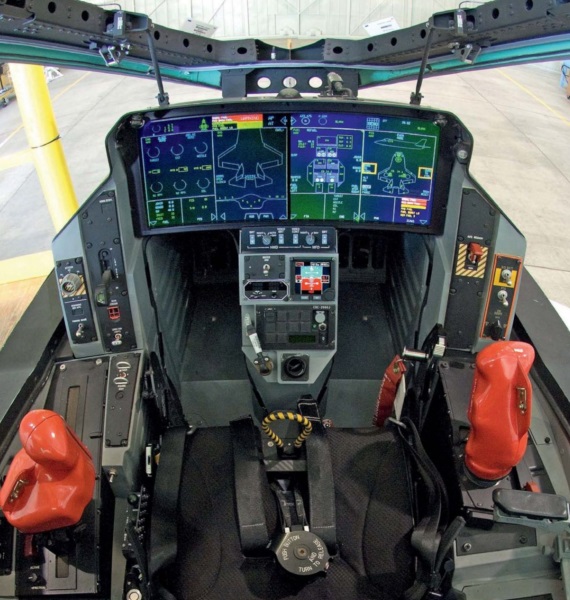
The pilot flew the aircraft with HOTAS controls; the PCD was touch-sensitive and functioned to an extent as a reprogrammable keyboard, resulting in an austere cockpit control layout.
The "smarts" of the F-35 have been particularly appreciated by pilots flying the F-35B STOVL version. Short take-offs in the Harrier were a troublesome affair that required the pilot to have "three hands": one for the throttle, one for the stick, and the third for the lever that controlled the direction of the Harrier's swiveling exhaust nozzles. An F-35B pilot, in contrast, flew the plane with stick and throttle, with the software handling the fine details of short take-off: the pilot simply pressed a "button" on the PCD to convert from vertical to forward flight, or the reverse. In vertical flight, the left-hand stick controlled rate of ascent or descent; if the pilot let it go, the aircraft would sit in hover. It has been said the pilot can eat a sandwich and take a nap until the aircraft runs out of fuel.
While the Harrier had reaction control thrusters driven by engine bleed to provide low-speed maneuverability, the F-35B simply modulated the four points of its vertical-lift system -- the pivoting exhaust, the two wing exhaust ducts, and the lift fan -- to provide control. That would be difficult or impossible to do manually. The pilot sat on a Martin-Baker Mk.16E ejection seat; a next-generation ejection seat was considered for production aircraft, but not proceeded with.
* Although the F-35 was originally designed as a strike / interdiction aircraft, it is now seen as a multirole aircraft, able to act as a reconnaissance platform and interceptor as well. Work is now underway to have it perform the "suppression / destruction of enemy air defenses (SEAD / DEAD)" mission. It always had a limited SEAD capability, but it is now being brought up to full function, with the AARGM-ER seen as the primary offensive weapon.
Support is in the works for other new munitions, including the long-range AIM-260 follow-on to the AMRAAM, the antiship Joint Strike Missile, and the long-range Stand-in Attack Missile (SiAW) -- SiAW being a multirole derivative of the AARGM-ER. There is also work towards the support of drones, including those dropped from a stores pylon, and larger runway-launched "loyal wingman" drones.
BACK_TO_TOP* The US Marines, having been a major player in the F-35 program, have an ambitious scheme to use the F-35 to turn their amphibious assault ships -- helicopter carriers, in effect -- into air power projection platforms. Typically, an amphibious assault ship might have a complement of, say, six Harrier jumpjets, eight MV-22 Osprey tiltrotors, and four CH-53E heavylift helicopters. By leaving off the CH-53Es and retaining only four MV-22s, a total of 16 or possibly 20 F-35s could be carried, turning an amphibious assault ship into a powerful strike element, as an alternative to its more traditional role of providing the spine of amphibious assaults.
Britain plans to obtain 138 F-35Bs and made haste to get them into service, for operations off the new carriers HMS QUEEN ELIZABETH and HMS PRINCE OF WALES. Both have "ski jump" prows to allow the F-35Bs to perform short rolling take-offs. Trials using a land-based ski jump ramp were performed in 2015, and revealed no difficulties. The British had actually opted for F-35Cs at first, but found that adding a catapult system to the carriers made them much more expensive.
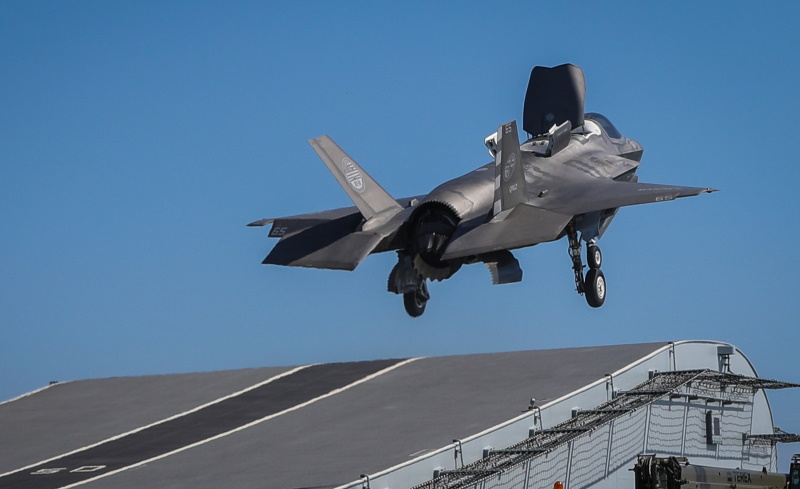
The British are also planning to use the British AIM-132 ASRAAM and European Meteor BVRAAM air-to-air missiles with the F-35, though not their Brimstone air-to-surface missile. Brimstone is to be replaced by the "Selective Precision Effects At Range (SPEAR)" family of munitions, which will be supported on British F-35s. The Meteor BVRAAM may also be used by other nations.
Along with the UK, other countries that have obtained or will obtain the F-35 include:
Turkey planned to obtain 100 F-35As, but that exercise was derailed by problems in US-Turkey relations -- Turkish acquisition of Russian and Chinese weapons being a factor -- with the production rescheduled for the USAF. The Turks are considering building their own equivalent instead. However, Turkish involvement in support of Ukraine after the Russian invasion of that country in 2022, and attendant bad Turkish relations with Russia, along with Turkish objection to admitting Finland and Sweden into NATO, may change the equation.
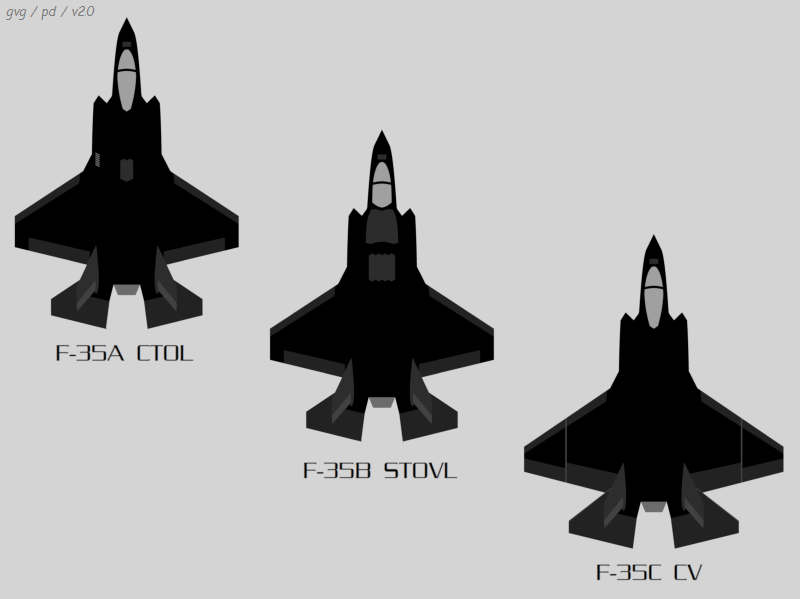
* The US military has suffered some embarrassment over the F-35, and not without fair cause. However, given how long the F-35 is likely to remain in service, its painful gestation may not seem so significant some decades on.
The USAF claimed that in the Nevada Red Flag exercise in early 2017, the F-35 achieved a 15:1 kill ratio against F-16 fighters flown as adversaries. Exactly how that kill ratio was compiled is not clear, since the F-35 flew alongside F-22 Raptors that took care of air combat, while the F-35s concentrated on strike, the job it was designed to do. However, Lieutenant Colonel George Watkins, an F-35 pilot and F-35 fighter squadron commander, claimed the F-35 shined in the exercise: "The first day we were here, we flew defensive counter-air, and we didn't lose a single friendly aircraft. That's unheard of."
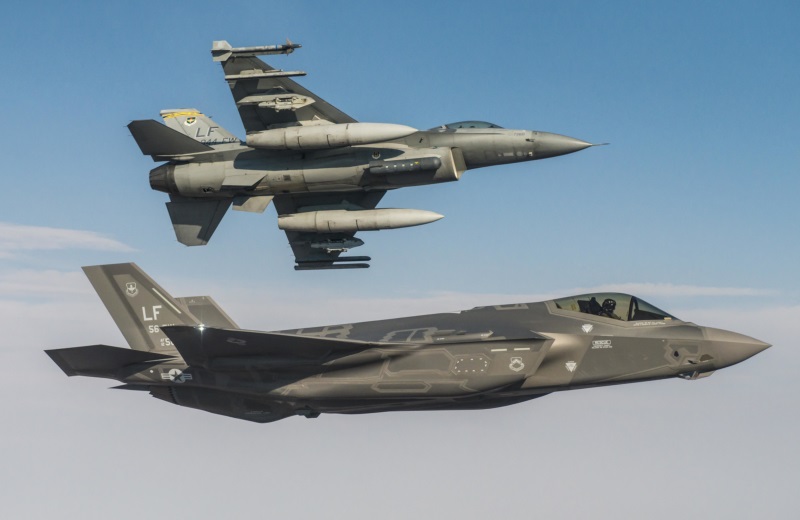
Dutch pilots, experienced on their F-16s and moving up to the F-35, had similar experiences in training exercises -- those flying F-16s against F-35s finding it very hard to score on an F-35, while being taken out repeatedly themselves. As they pointed out, the F-35 is a substantially bigger machine than the F-16, carrying twice the fuel and three times the payload, with about 50% greater empty weight; that certainly means greater range and striking power, but it also means it's not quite so light on its feet. One Dutch pilot found that no great penalty:
BEGIN QUOTE:
... the F-35 loses energy a bit faster than the F-16 at higher speeds -- but the low-speed handling is amazing. The F-35 pilot has the option of continuously pointing the nose at the adversary, even at ridiculously low speeds -- which is a great combination to have, in combination with high off-boresight missiles and a helmet-mounted sight.
END QUOTE
Later in 2017, in response to criticisms that the F-35 was a dog in air combat, test pilot Billie Flynn put on an impressive display at the Paris Air Show. Flynn said the F-35 was more agile than the F/A-18 Hornet, F-16 Viper, or Eurofighter, adding that the machine he flew was fully combat-armed, its internal weapons bays loaded up. He commented: "All of those airplanes that do air shows -- the Hornet, Viper -- they're all slicked off without all the external stores. They're a party trick at an air show, versus a combat-configured F-22 or F-35."
Dutch pilots recollected that in their early days of training on the F-35, at the time when rumors suggested the F-35 was an easy kill, adversaries in F-16s tried to take it on with the F-16s carrying external stores -- and got nowhere. They gradually reduced stores until they weren't carrying any, and still didn't have an easy time of it. F-35 pilots didn't hesitate to engage in air combat when they were carrying offensive stores internally.
Flynn, reflecting on his airshow performance, said: "This aircraft down low in this environment is an absolute monster. It is more powerful, it is more aggressive than any of us, including those of us that fly the F-35, would have imagined before we began this flight-demo process."
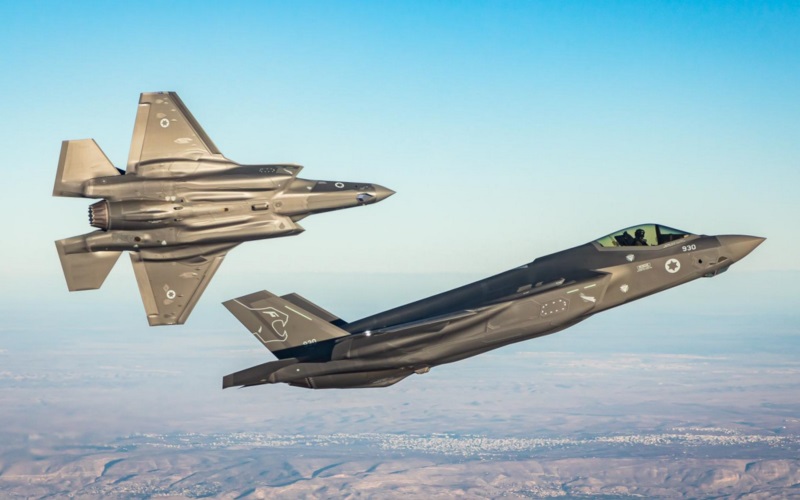
Initial combat action of the F-35 took place in 2018, the first instance being Israeli F-35As involved in two strikes in Syria -- the aircraft's stealth no doubt being very useful in an environment with sophisticated air defenses. The first US combat action took place on 27 September 2018, when US Marine F-35Bs, flying from the amphibious assault ship USS ESSEX, conducted attacks on Afghan insurgents. USAF F-35As saw their first combat at the end of April 2019, flying strikes against Islamic State insurgents in Iraq. RAF F-35Bs, flying out of Cyprus, similarly performed strikes on Islamic State insurgents from June 2019.
The USAF is now flying an F-35 flight-demonstration team at airshows. The Air Force is planning to seed the 65th Aggressor Squadron at Nellis AFB in Nevada with nine early-build, non-combat capable F-35As to provide training for combat against 5th-generation fighters. There has been talk of the US Navy developing an air-superiority version of the F-35C, with CFTs to permit long stand-off range. The Navy F-35C buy would, in that scenario, be split into strike and air-superiority machines.
There has been talk that the F-35 will be the last of its breed. The expense of development of new piloted combat aircraft has become increasingly unbearable, and the increasing availability of deadly air defense technologies may be outpacing improvements in aircraft survivability. The future, in that vision, will be unpiloted combat aircraft (UCA). However, there's been a backlash against that vision that instead sees UCAs as complementary to piloted combat aircraft -- with energetic work on loyal wingman drones, mentioned above, that can accompany a piloted aircraft into the battle zone to act as relatively low-cost force multipliers. The first loyal wingmen drones should be in operation later in this decade.
BACK_TO_TOP* In the summer of 2009, some clever people at Lockheed Martin came up with a set of images of the F-35 rendered in USAF Thunderbirds flight demonstration team colors. It was a snappy exercise that attracted considerable attention online, and led to a number of flightsim copycats "skins". Will the Thunderbirds ever fly F-35s? That remains to be seen.
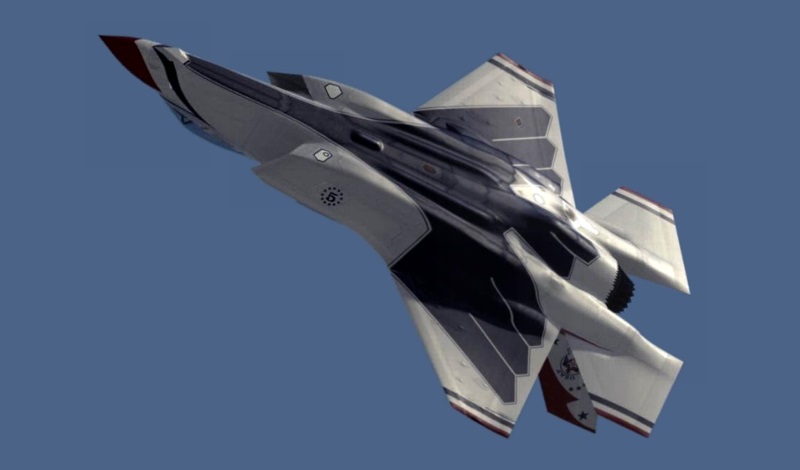
* Sources include:
The JSF Program Office website was a very useful source of many details.
* Illustrations credits:
* Revision history:
v1.0 / 01 dec 99 / Merged into F-22 document in May 2000. v2.0.0 / 01 jan 02 / Restoration into separate document & rewrite. v2.0.1 / 01 nov 02 / Review & polish. v2.0.2 / 01 nov 04 / Review & polish. v2.0.3 / 01 nov 06 / Review & polish. v2.0.4 / 01 nov 08 / Review & polish. v2.0.5 / 01 aug 09 / Added Thunderbirds F-35. v2.0.6 / 01 may 10 / Review & polish. v2.0.7 / 01 apr 12 / Cancellation of F136 Alternate Engine. v2.1.0 / 01 mar 14 / Document reorganization, update on program status. v2.1.1 / 01 feb 16 / Review & update. v2.2.0 / 01 jan 18 / General clean-up and update. v2.2.1 / 01 feb 18 / Review, update, & polish. v3.0.0 / 01 jan 20 / General rewrite. v3.1.0 / 01 mar 21 / Review, update, & polish. v3.2.0 / 01 mar 23 / Review, update, & polish.BACK_TO_TOP
